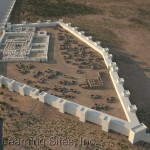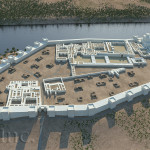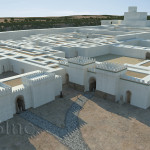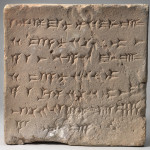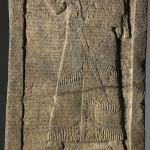Citadel at Nimrud
Nimrud (in northeastern Iraq, just south of Mosul, ancient Nineveh) became the capital of the Assyrian empire during the early 9th-century reign of King Ashurnasirpal II. His new palace on the citadel there became the prototype for all subsequent Assyrian royal palaces in terms of scale, decorative programs, and function. Ashurnasirpal’s work was expanded by his son and successor Shalmaneser III, who ruled from 859 to 824 BCE and who firmly established Nimrud as a major cult center to rival those throughout Assyria and Babylonia when he added a ziggurat (as well as minor administrative buildings, temples, and a new entrance) to the citadel.
Interactions, both on the ground and in narrative texts, between the Assyrians and the people of the land of Judah and Israel are a major part of 9th-century history. While work continued at Nimrud, Shalmaneser set off to reassert Assyrian hegemony over dozens of smaller kingdoms from Anatolia, to Syria, to Israel (setting the tone for similar campaigns by his successors, most notably by Sennacherib, as can be seen in the accompanying Lachish Battle Reliefs videos). In 853 BCE, after 6 years of military actions, he chronicled his successes on a massive limestone stela, which was discovered at Kurkh in modern Üçtepe (southern Turkey). Among the events related on the stela, the text tells us: “Qarqar, his royal city, I destroyed…2000 chariots, 10,000 soldiers of Ahab the Israelite…came against me….I battled with them….” Apparently, Ahab was part of an alliance that was defeated by the Assyrians at the battle at Qarqar. The stela is one of a handful of ancient monuments that mentions the term “Israel” although there is still some uncertainty about the exact person named Ahab in the inscription.
Once back at Nimrud, Shalmaneser added a new small royal residence next to his father’s palace. The gatehouse to the new residence whose gateway copied the basic design features found on of his father’s palace entrance, including an obelisk to further boast about the king’s military achievements. This so-called Black Obelisk was discovered by in 1846 and seems to have been erected by Shalmaneser in 826 BCE. This public monument has relief sculptures on all four sides glorifying the achievements of the king and his chief minister. It lists 31 years of their joint military campaigns and the tribute they exacted from their neighbors, including camels, monkeys, an elephant, and a rhinoceros. Assyrian kings often collected exotic animals and plants as an expression of their power. Five scenes of tribute are depicted, each of which occupies four panels around the obelisk and each is identified by a line of cuneiform script above the panel. The caption of the second register from the top reads: “I received tribute from Jehu of the house of Omri, silver, gold, a gold bowl, a gold tureen, gold vessels, gold buckets, tin, the staffs of the king’s hand, and spears.” This mention of the biblical Jehu of Bit Omri (the ancient northern kingdom of Israel) also provides the earliest surviving depiction of an Israelite. According to 1 Kings 29-36, around 841 BCE, the kingdom of Omri was taken by Jehu, a usurper, who broke the alliances with Phoenicia and Judah, and submitted to Assyria.
In 824 BCE, only two years after erecting the Black Obelisk, Shalmaneser dies in an empire-wide civil war.
Images
Bibliography
- Curtis, J.E. et al. (eds.). 2008. New Light on Nimrud: Proceedings of the Nimrud Conference, 11th-13th March 2002. London: British Institute for the Study of Iraq.
- Grayson, A.K. 1996. Assyrian Rulers of the Early First Millennium BC II (858-745 BC) (Royal Inscriptions of Mesopotamia. Assyrian Periods. Volume 3), Toronto: University of Toronto Press.
- Hussein, Muzahim M.; David Kertai & Mark Altaweel. 2013. “Nimrud and its Remains in Light of Iraqi Excavations from 1989-2002,” pp.91-108 in David Kertai & Peter A. Miglus, eds., New Research on Late Assyrian Palaces: conference at Heidelberg, January 22nd, 2011. Heidelberg: Heidelberger Orientverlag.
- Kertai, David. 2013. “The Multiplicity of Royal Palaces: how many palaces did an Assyrian king need?” pp.11-22 in David Kertai & Peter A. Miglus, eds., New Research on Late Assyrian Palaces: conference at Heidelberg, January 22nd, 2011. Heidelberg: Heidelberger Orientverlag.
- Lambert, W. G. 1974. “The Reigns of Ashurnasirpal II and Shalmaneser III: An Interpretation.” Iraq v.36.1/2:103-9.
- Layard, A.H. 1849. Nineveh and its Remains, London: John Murray.
- Marcus, M. I. 1987. “Geography as an Organizing Principle in the Imperial Art of Shalmaneser III.” Iraq v.49: 77-90.
- Oates, D. and J. Oates. 2001. Nimrud: An Assyrian Imperial City Revealed. London: British School of Archaeology in Iraq.
- Paley, Samuel M. 2003. “The citadel of Nimrud (Kalhu) / La Citadelle de Nimrud (Kalhu)”. Bulletin. The Canadian Society for Mesopotamian Studies / La Société canadienne des études mésopotamiennes. v.38 (September).
- Reade, J.E. 2002. “The Ziggurrat and Temples of Nimrud.” Iraq v.64:135-216.
- Russell, J.M. 1998. “The Program of the Palace of Assurnasirpal II at Nimrud: Issues in the Research and Presentation of Assyrian Art.” American Journal of Archaeology v.102:655-715.
- Sobolewski, Richard P.1982. “The Shalmaneser III Building in the Central Area of the Nimrud Citadel,” Archiv für Orientforschung, Beiheft v.19:329-340.

